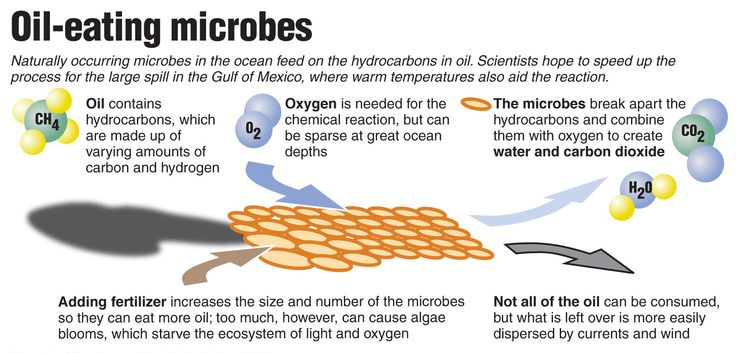- Home
- Prelims
- Mains
- Current Affairs
- Study Materials
- Test Series
 EDITORIALS & ARTICLES
EDITORIALS & ARTICLES
Bioremediation
BIOREMEDIATION
Bioremediation is a biotechnical process, which abates or cleans up contamination. It is a type of waste management technique which involves the use of organisms to remove or utilize the pollutants from a polluted area.
There are several remedies where contaminated water or solid is purified by chemical treatment, incineration, and burial in a landfill. There are other types of waste management technique which include solid waste management, nuclear waste management, etc. Bioremediation is different as it uses no toxic chemicals.
Microorganisms like Bacteria and Fungi are the main role player when it comes to executing the process of Bioremediation. Bacteria are the most crucial microbes in this process as they break down the waste into nutrients and organic matter. Even though this is an efficient process of waste management but bioremediation cannot destroy 100% contaminants. Bacteria can easily digest contaminants like chlorinated pesticides or clean oil spills but microorganisms fail to destroy heavy metals like lead and cadmium.

There are many bacteria that can clean or remove the oil from ocean water by degrading hydrocarbons. These bacteria are known as hydrocarbon degrading bacteria. Pseudomonas can digest the hydrocarbons in oil. They are gram negative bacteria that are found in soil, water and plants and animals. A species called Pseudomonas putida is widely used in oil spill decontamination or bioremediation. It is known to break down many aromatic compounds like hydrocarbons.
Ananda Mohan Chakrabarty, a genetic engineer working for General Electric had developed a bacterium, today known as Pseudomonas putida (derived from the Pseudomonas genus), that is capable of metabolizing the hydrocarbons that constitute crude oil. No naturally occurring bacteria shows this property, and it is used in the field of bioremediation or biodegradation of oil.
Types of Bioremediation
Bioremediation is of three types –
1) Biostimulation
As the name suggests, the bacteria is stimulated to initiate the process. The contaminated soil is first mixed with special nutrients substances including other vital components either in the form of liquid or gas. It stimulates the growth of microbes thus resulting in efficient and quick removal of contaminants by microbes and other bacterias.
2) Bioaugmentation
At times, there are certain sites where microorganisms are required to extract the contaminants. For example – municipal wastewater. In these special cases, the process of bioaugmentation is used. There’s only one major drawback in this process. It almost becomes impossible to control the growth of microorganisms in the process of removing the particular contaminant.
3) Intrinsic Bioremediation
The process of intrinsic bioremediation is most effective in the soil and water because of these two biomes which always have a high probability of being full of contaminants and toxins. The process of intrinsic bioremediation is mostly used in underground places like underground petroleum tanks. In such place, it is difficult to detect a leakage and contaminants and toxins can find their way to enter through these leaks and contaminate the petrol. Thus, only microorganisms can remove the toxins and clean the tanks.
PHYTOREMEDIATION
Phytoremediation = Phyto (Plant) + Remedium (Restoring balance or Remediation)
Phytoremediation is a cost-efficient plant-based approach that takes advantage of the ability of plants to concentrate elements and compounds from the environment and metabolize various molecules in their tissues. It refers to the natural ability of certain plants to bioaccumulate, degrade, or render harmless contaminants in soil, water, or air. Toxic heavy metals and organic pollutants are the targets for phytoremediation.
Phytoremediation is usually applied to contaminated soil or water environments that are static. Some of the examples include the restoration of abandoned metal mine workings and sites where polychlorinated biphenyls have been dumped during the manufacture and mitigation of ongoing coal mine, discharges reducing the impact of contaminants in soils, water, or air.
Contaminants such as metals, pesticides, solvents, explosives, and crude oil and its derivatives, have been mitigated in phytoremediation projects worldwide. Many plants such as mustard plants, alpine pennycress, hemp, and pigweed have proven to be successful at hyperaccumulating contaminants at toxic waste sites.
Not all plants can accumulate heavy metals or organic pollutants due to differences in the physiology of the plant. Even cultivars within the same species have varying abilities to accumulate pollutants.
Advantages:
- In principle, plants that engage in phytoremediation of toxic elements could be harvested, thus removing these elements from the polluted site.
- The plants can be easily monitored
- The possibility of the recovery and re-use of valuable metals (by companies specializing in “phytomining”)
- It is potentially the least harmful method because it uses naturally occurring organisms and preserves the environment in a more natural state.
- It preserves the topsoil, maintaining the fertility of the soil
- It increases soil health, yield, and plant phytochemicals
Disadvantages:
- Phytoremediation simply relocates toxic heavy metals, it does not remove them from the locale.
- Phytoremediation is limited to the surface area and depth occupied by the roots.
- Slow growth and low biomass require a long-term commitment
- With plant-based systems of remediation, it is not possible to completely prevent the leaching of contaminants into the groundwater. The survival of the plants is affected by the toxicity of the contaminated land and the general condition of the soil.
- When taking up heavy metals, sometimes the metal is bound to the soil organic matter, which makes it unavailable for the plant to extract.









 Latest News
Latest News General Studies
General Studies